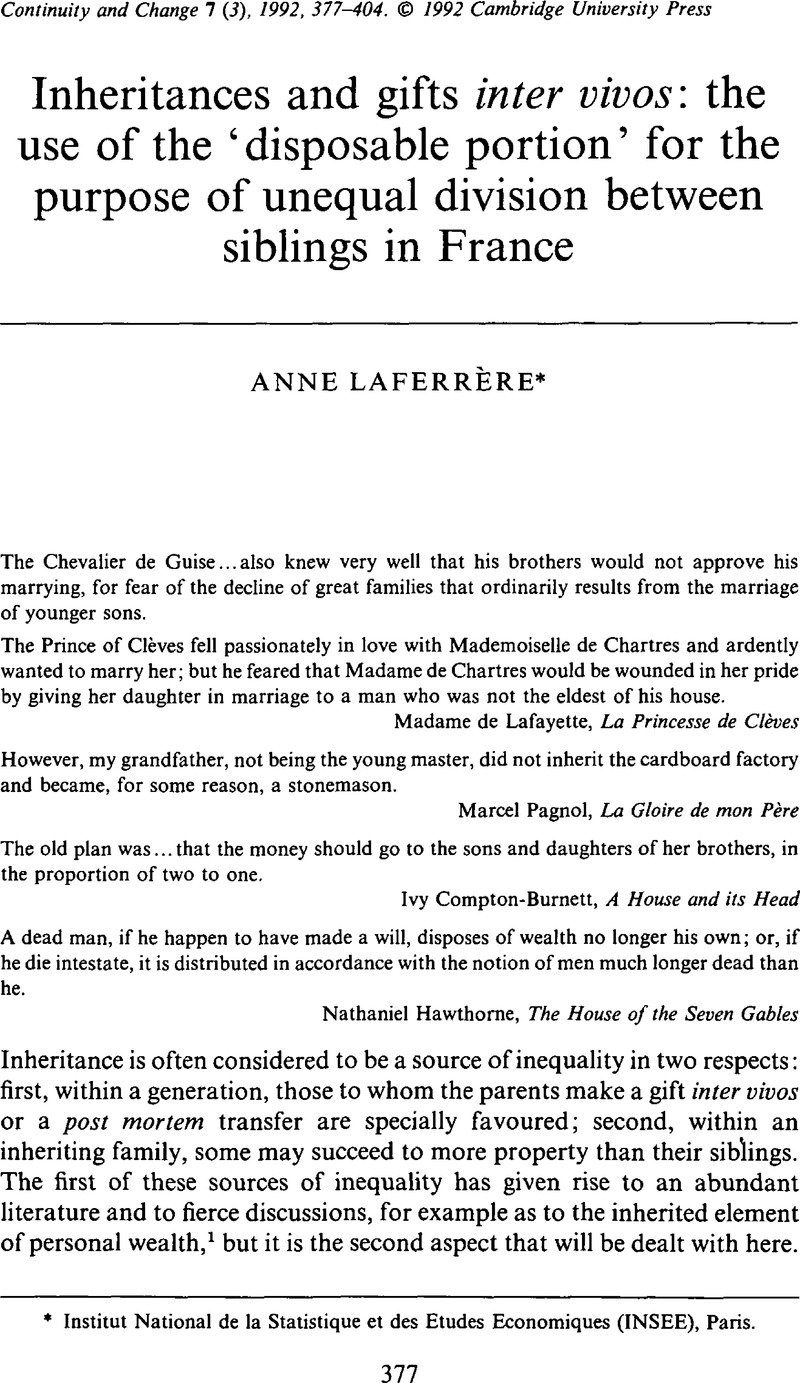Article contents
Inheritances and gifts inter vivos: the use of the ‘disposable portion’ for the purpose of unequal division between siblings in France
Published online by Cambridge University Press: 11 November 2008
Abstract

- Type
- Articles
- Information
- Copyright
- Copyright © Cambridge University Press 1992
References
ENDNOTES
1 Kotlikof, Laurence and Summers, Lawrence, ‘The role of intergenerational transfers in aggregate capital accumulation’, Journal of Political Economy 89, 4 (1981), 706–32CrossRefGoogle Scholar; Modigliani, Franco, ‘Measuring the contribution of intergenerational transfers to total wealth: conceptual issues and empirical findings’, in Modelling the accumulation and distribution of personal wealth (Oxford, 1988)Google Scholar; Laferrère, Anne, ‘La part héritée de la fortune: entre le quart et la moitié’, in Mélanges en l' honneur de Jacques Desabie (Paris, 1989).Google Scholar
2 Shammas, Carole, Salmon, Marylynn and Dahlin, Michel, Inheritance in America. From colonial times to the present (New Brunswick, N.J., 1987), 268–9.Google Scholar
3 Wilhelm, Mark O., ‘Bequest behaviour and the effect of heirs' earnings: testing the altruistic model of bequests’, unpublished PhD dissertation, Pennsylvania State University, 1990.Google Scholar
4 Arrondel, Luc and Laferrère, Anne, ‘Successions et heritiers a travers les donnees fiscales’, Economie et Prevision 100–1 (1991).CrossRefGoogle Scholar
5 And this just one year after the extension of the marital deduction. See Bernheim, Douglas, ‘Does the estate tax raise revenues?’ in Summers, L. H. ed., Tax policy and the economy, vol. 1, NBER and MIT Press Journals (Cambridge, 1987).Google Scholar
6 Menchik, Paul L., ‘Primogeniture, equal sharing, and the U.S. distribution of wealth’, The Quarterly Journal of Economics (03 1980), 299–316CrossRefGoogle Scholar; Tomes, Nigel, ‘Inheritance and inequality within the family: equal division among unequals, or do the poor get more?’, in Modelling.Google Scholar
7 However a high proportion of married couples in France have made the special form of will consisting of a gift to the survivor.
8 There are also psychological obstacles to giving to outsiders, given the potential strength of family enmity. As Nathaniel Hawthorne wrote in The House of the Seven Gables: ‘But there is one thing which men so rarely do, whatever the provocation or inducement, as to bequeath patrimonial property away from their own blood… In view of death, the strong prejudice of propinquity revives, and impels the testator to send down his estate in the line marked out by custom so immemorial that it looks like nature.’
9 In 1981, 41 per cent of respondents thought that the law does not permit the reduction of the children's share in favour of others or outsiders and 29 per cent confessed their ignorance of the subject (survey carried out by the French Chancellery, the Laboratoire de Sociologie Juridique and the ARCmc).
10 Gotman, Anne, Hériter (PUF, Collection Economie en liberté, Paris, 1989).Google Scholar
11 Barcelo, Ramon, ‘Transmission héréditaire et système de production: le cas de la Soule (Pyrénées atlantiques)’, Sociologie du travail 30, 3 (1988).CrossRefGoogle Scholar
12 Augustins, George, Comment se perpétuer ? Devenir des lignées el destins des patrimoines dans les paysanneries européennes (Société d' ethnologie, Nanterre, 1989).Google Scholar
13 These interviews, carried out as part of the preparation for INSEE's 1992 Actifs financiers survey, are still being processed. We shall return to them later.
14 Laferrère, Anne, Successions et héritiers (INSEE Cadrage, no. 4, Paris, 1990)Google Scholar. Among them 60 per cent were not taxed in 1987.
15 The amounts were brought to present value using an implicit Gross Domestic Product (GDP) index. The dates when the gifts were made are not always indicated and were two at most. A median date was applied in cases of non-response.
16 There may in addition be cases where children have pre-deceased the parent, but no account has been taken of the grandchildren representing the pre-deceased children concerned.
17 The hypothetical case mentioned earlier of a deceased person making unequal gifts to take account of inflation does not occur in practice.
18 For a very rich parent the amount bequeathed is high relative to his children's differences in earnings. It might therefore not be worth dividing unequally to compensate those differences because the size of the bequest will dominate the magnitude of the differences in earnings (Wilhelm, , ‘Bequest behaviour’).Google Scholar
19 Becker, Gary S. and Tomes, Nigel, ‘Human capital and the rise and fall of families’, Journal of Labor Economics 4 (1986)CrossRefGoogle ScholarPubMed; Cox, Donald, ‘Motive for private income transfers’, Journal of Political Economy 96, 2 (1987), 508–46.CrossRefGoogle Scholar
20 These questions were in fact placed first, third, sixth and ninth in a series of eleven. They are reproduced in Appendix 4.
21 See, in particular, his illuminating analysis of King Lear in Shakespeare, Les feux de l' envie (Paris, 1990), 225–8.Google Scholar
22 A logistic analysis was made of the replies. The ceteris paribus variables were: occupational group (6 groups), age (3 groups), number of children (5 groups) and income (6 groups).
23 See Deville, Jean-Claude, ‘La fécondité serait-elle héréditaire?’, Economie et Statistique 116 (1979).CrossRefGoogle Scholar
- 1
- Cited by




